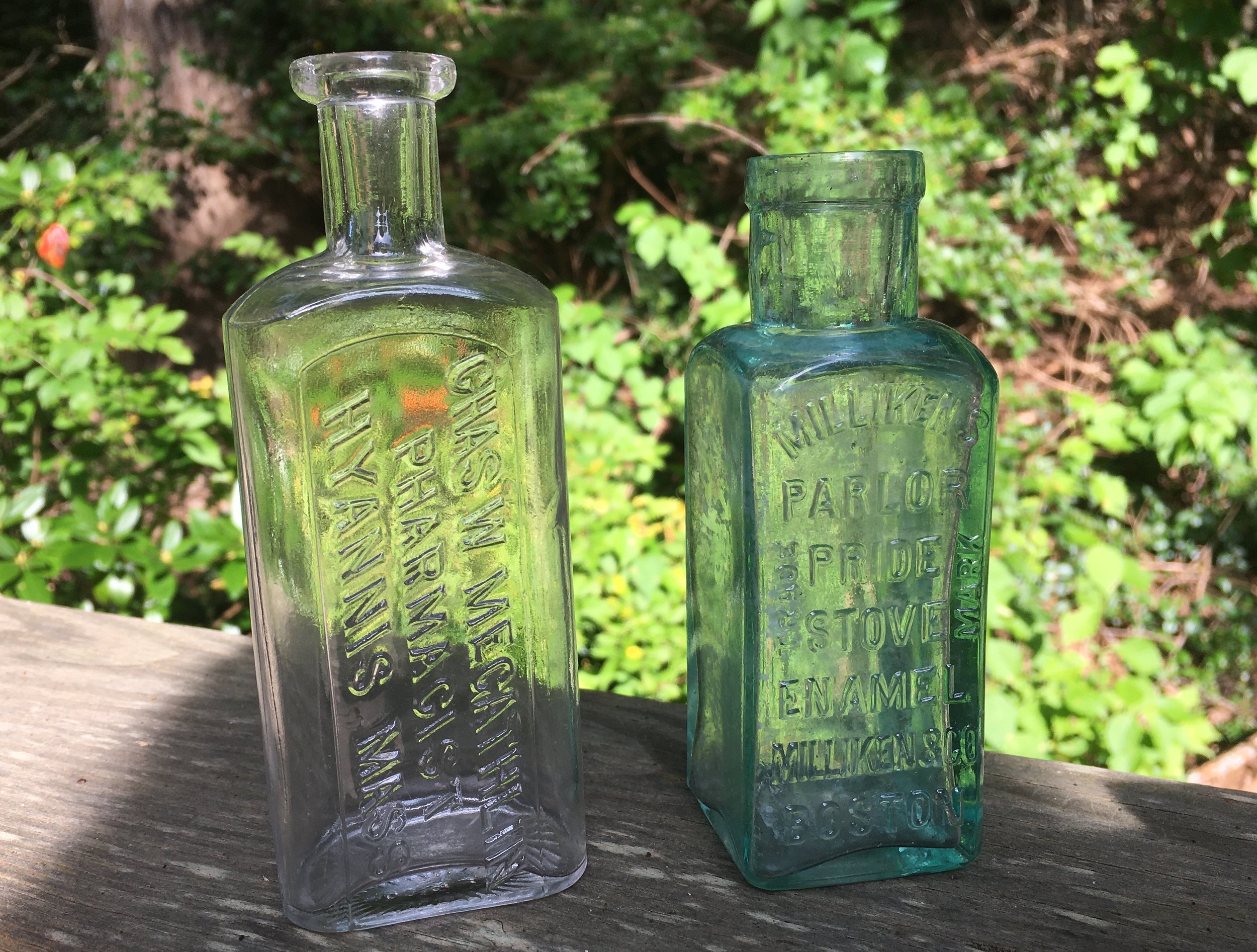Long ago people simply dug a hole out back or filled a ditch in the woods with their unwanted items. Anyone who has owned an old home has found bits of broken china, pipe stems or coins when digging in the garden. Older Cape Codders knew where some of those old dumps were in the woods and went to dig out treasures like old bottles. Later each village in the town of Yarmouth had its own dump which consisted of trash being piled on the ground with a road running between the piles.
Old bottles found in Yarmouth Port
The South Yarmouth dump was up a dirt road on the north side of Long Pond on what is now Regional Avenue about where Diane Avenue is and covered about two acres. There was no onsite keeper but the trash was occasionally burned. No one had a bulldozer or a front end loader so the trash was not buried. Of course there were dump pickers and a few people probably lived off of the proceeds or furnished their home with the cast offs.
Some brought their own trash and others had it picked up. Harold Kelley had a 1948 Dodge dump truck and picked up rubbish with his brother Don. Bill Angell and Edward (Dooley) Johnson bought the business and replaced the Dodge with a “packer” and expanded the business. In the 1960s Peter, Barry, and Brian Homer bought out Bill Angell and Homer Brothers Rubbish was formed. In 1972 they merged with Browning, Ferris Industries (BFI).
When the South Yarmouth dump was closed about 1950, my father bought the land for $75.00. Within a week he sold it for $125 and made $50. Now there are several homes located there.
A map circa 1935 showing two of the town dumps.
The Bass River dump was located several hundred feet up Forest Road from Long Pond Drive and before the herring run. I remember a man in a chair tending it with a rake and a pitch fork. Forest Road was a two rut dirt road at that time. The West Yarmouth dump was on Sandy Pond Road near the West Yarmouth Fire Station. My father, John Sears, was on the fire department and on many a Sunday afternoon the fires got out into the woods or were burned as a drill.
The north side’s dump was off Summer Street southwest of Dennis Pond. It was perfectly all right to shoot rats and use bottles and cans for target practice.
When the present Yarmouth landfill was opened in 1950, there was a small two or three acre pond with a camp on the land. The Fire Department was designated to clear it by burning down the camp and both Station One (south-side) and Station Two (north-side) wanted the chance burn it on a Sunday. Chief Dana Whittemore wouldn’t choose and gave the job to whoever got there first. Well, the night before, my father and Bill Angell went there with five gallons of gasoline and poured it throughout the house with a trail away from it for about 100 yards. When a match was struck it rippled toward the structure and suddenly the whole place erupted. When the fire crews arrived in the morning, there were only a few smoldering ashes. No one knew who the culprits were for a long time after.
The new central dump eliminated the village dumps. All rubbish, including stoves, refrigerators, mattresses and more were pushed into the pond. A contract to “keep the dump” was let out, and I remember Carl White pushing the trash with a snowplow on his dump truck. Soon the pond filled and the area expanded.
During the 1960s and 1970s the town experienced huge growth. The rubbish now piled on top of the ground had to be covered each night and sand was pushed over it with a bulldozer. Bill Angell again had the contract and Eddie Gibbs ran the bulldozer. With the growth of the town came land-clearing, and trees, stumps and turf came in by the truckload. Adam Watson took over but never could keep up. There were narrow trails through piles of stumps which just seemed to grow and, of course, there were fires.
Frank Johnson, Alec Todd, Herton Hallett and John G. Sears, Jr.
By now I was on the Fire Department and we spent many a day pouring water into holes to try and drown out a fire burning 25 feet below the surface. Sometimes we dug and sometimes we laid a line from a town hydrant. Occasionally I stayed all night with another man moving the fire hoses to different places. When cesspools were pumped the “honey wagons” just emptied their loads on top of the ground in an area designated for them where it just sank into the dirt as they drove away.
When the town decided that we could not continue to bury our trash, a contract was signed to haul the rubbish off-Cape to be burned at an incinerator and a transfer station was built. Along with that, a septic treatment plant was built to take care of the pumping of the cesspools.
It was the state’s directive to cover and seal the old dump or so-called landfill. There was an enormous pile of rubbish mixed with sand that had to be covered with a plastic membrane and a couple of feet of clay to seal it. It would cost around 18 million to do the job and if only just covered, it would be useless land for years.
A decision was made to grade the land into hills and valleys and build a nine hole golf course. Along with that, adjacent land was acquired and soccer fields and basketball courts were built. This was later dedicated and named the Peter Homer Park. Peter had held many town positions, the last being superintendent of the Transfer Station.
I can’t possibly explain the feeling I had one evening as I played golf alone on the new course. I stepped on top of that finely mowed grassy hill and looked down on a team of soccer players in uniform off in the distance. The lights lit up the field. I remembered back to that pond, being filled with everything you can imagine. I saw the mountains of stumps and brush, the smoky fires that burned for days. Now stood neat buildings and orderly containers to sort and recycle bottles, cans, metal, and paper which could be neatly loaded and hauled off-Cape.
written by John Sears III
Added note – The Links 9 golf course was awarded a million dollar grant from the state, being the largest recycling project to that time! Links 9 was opened in 1999, officially in 2000. Drivers on Route 6 will remember all the seagulls near the former exit 8. The 50 foot tall landfill, which covered 57 acres, contains 40 wells which collect methane gas. On top of the trash is a six inch layer of sand, covered by durable black plastic sheets fused together. Another 18 inches of sand covers the plastic and it is capped by eight inches of topsoil. More than 240,000 cubic yards of sand were used.
The former town dump, now a golf course.







